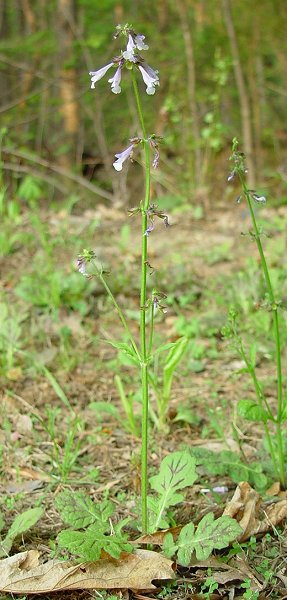Salvia lyrata L.
Lyre-Leaved Sage

Native
CC = 3
CW = 3
MOC = 38
© SRTurner
Salvia lyrata L.Lyre-Leaved Sage | |
 |
Native CC = 3 CW = 3 MOC = 38 |
© SRTurner |
|
Family - Lamiaceae Habit - Perennial forb with a short, thick rootstock. Stems - Erect, to 50 cm, 4-angled, scapose, usually simple, sparsely pubescent with short, more or less spreading hairs. Leaves - Mostly basal, sometimes opposite on stem. Basal leaves several at flowering, the petiole 20-70 mm long, the blade 6-15 cm long, oblanceolate to elliptic, oblong-obovate, or oblong-elliptic in outline, the first set of leaves deeply pinnately lobed with a large terminal lobe and several pairs of smaller, spreading, rounded to broadly pointed, lateral lobes, the later leaves progressively less divided, sometimes unlobed and more or less spatulate, the margins otherwise entire or with a few, irregular, blunt teeth, the surfaces glabrous or sparsely to moderately short-hairy. Stem leaves absent or only 1 or 2 pairs, sessile or short-petiolate, the blade similar to those of the basal leaves, but only 2-7 cm long.
Inflorescence - Spikes with evenly spaced verticels terminating stem. Flowers typically in clusters of 4 equaling to 8 per verticel. Flowers on pedicel to 3 mm long, densely pubescent. Bracts usually persistent, 4-7 mm long, linear to lanceolate.
Flowers - Calyces 6-9 mm long at flowering, becoming elongated to 8-12 mm at fruiting, moderately short-hairy below the lobes, the upper lip shallowly 3-lobed, the lower lip more deeply 2-lobed. Corollas bilabiate, 18-30 mm long, the outer surface sparsely to moderately short-hairy mostly on the tube, pale lavender to pale blue or white, the tube much longer than the calyx, the upper lip usually folded longitudinally but relatively straight, truncate, and not hooded, entire, the lower lip with relatively small lateral lobes and a depressed-oval to depressed-obovate central lobe, this usually shallowly and broadly notched at the tip. Stamens 2, adnate near apex of throat, included. Filaments to 2 mm long, glabrous. Anthers brownish-purple. Style to 3 cm long, exserted. Stigma unequally 2-lobed.
Fruits - Nutlets 1.7-2.2 mm long, the surface dark brown, with dense, minute tubercles, otherwise glabrous. Flowering - April - June. Habitat - Bottomland and mesic forests, streambanks, fens, bluffs, pastures, lawns, cemeteries, railroads, roadsides, and disturbed areas. Origin - Native to the U.S. Lookalikes - None close. Other info. - This species is common in the southeastern third of Missouri. It is found throughout the southeastern continental U.S. The plant is recognized by its pale bluish to white flowers, nearly leafless stems, and lyrate basal leaves. The inflorescences typically have a somewhat disarrayed appearance rather than a neatly symmetrical arrangement, and the flowers often point slightly downward. The plant can bloom when quite small (15 cm), but can get to over 50 cm. Photographs taken in Brown Summit, NC., 4-25-02, and off Wire Road, Auburn, AL., 4-17-05 (DETenaglia); also at Shaw Nature Reserve, Franklin County, MO, 5-7-2007 and 5-20-2008, and St. Joe State Park, St. Francois County, MO, 5-5-2025 (SRTurner). |